Conservatives everywhere condemn the use of tax increases for fear of the Laffer Curve. This is the idea that if taxes are too high, people will lose the incentive to work and therefore revenue will actually decrease. It is most famous for its counter-intuitive argument that a tax cut could increase revenue. Unfortunately there is little or no evidence to support this claim. History clearly shows that cutting taxes does not increase revenue. The Laffer curve is a political idea used to justify tax cuts for the rich. It is not based on sound economics.

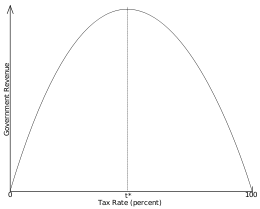
Most economists know the Laffer Curve isn’t true. An IGM survey of economists found that not a single one of them agreed that a tax cut will increase revenue. They all agreed that there was little or no supporting evidence. As David Autor said: “Not aware of any evidence in recent history where tax cuts actually raise revenue. Sorry, Laffer.” Or Kenneth Judd: “That did not happen in the past. No reason to think it would happen now.” It is rather politicians who use the Laffer Curve to defend polices they already had. Despite its abandonment by all main economists, it is still clung to by a small group more driven by ideology than evidence.
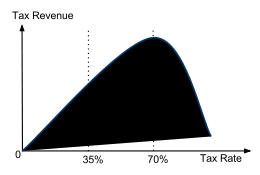
There is very little evidence behind this theoretical concept. It is a purely hypothetical idea without any backing evidence. Let me repeat that, there is no proof it is real. Its supporters argue that if taxes are 0% revenues will be zero (obviously enough) and if taxes are 100% then revenue will also be 0% (as no one will have an incentive to work). From this a curve resembling the one above is drawn. However there is absolutely no reason why it would be a smooth curve with the peak in the middle. Rather it could rise continuously before dropping off rapidly at the end (see below).
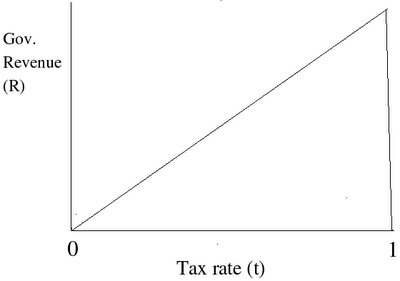
Or it could be a bunch of random squiggles as these “Neo-Laffer Curves” show.
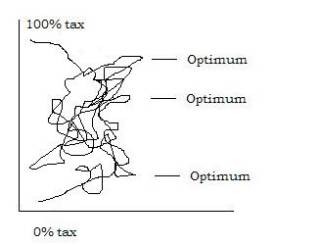
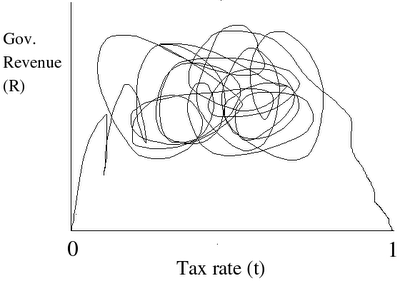
Conservatives argue that if taxes are too high then people will avoid he tax or simply not work. Most advocates abandon any pretence of studying the facts. Instead they claim taxes are too high at any rate. For example Reagan cut taxes from 70% to 50% because he argued taxes were too high and we were the wrong side of the Laffer Curve. Taxes were cut from 50% to 35% for the same reason. Now some people argue that 35% is too high and if we cut some more revenue will still rise. It soon becomes clear that conservatives argue taxes are too high no matter what the tax rate is. Their solution to every problem is to cut taxes. In their world we are permanently on the wrong side of the Laffer Curve.
There are numerous flaws in the argument. For example a 100% tax rate is essentially communism. While it is a terrible economic system it is one where tax revenue is still above 0. Another example is during war-time. Taxes were crushingly high, yet people still worked as hard as ever. After the Second World War America’s highest tax rate was 91% (albeit for a tiny number of extremely wealthy people), yet America still went through a unprecendented economic boom.
Conservatives who subscribe to the Laffer Curve usually are full of praise for the rich. Yet the Laffer Curve describes entrepreneurs as quite lazy. It presumes that some will not bother earning 100 million is they can only keep 50 million of it. Why would the supposedly most imaginative, innovative, hard-working and entrepreneurial people give up so easily? It ignores other motivators such as fame, respect and the thrill of success itself. Most millionaires have more money then they could ever spend, yet they don’t retire. That’s because money for its own worth isn’t important, it is the challenge and thrill of making it that drives them. All humans have a desire for success at everything they do and this is what drives them. If you don’t believe me, note how so many millionaires end up giving away their money. Why would someone work so hard only to give their money away?
If the rich won’t work unless they are incentivised, then what hope do the poor have? If a millionaire lacks incentive, why should anyone work for minimum wage? The truth is that working is an essential part of our culture. It defines who we are. Even if we didn’t need money we would still work. Not working is as socially acceptable as not talking. People will work hard at something they enjoy regardless of the money. For example this blog requires an enormous amount of work for no pay, yet I still devote enormous amounts of my time into it, because it is something I love doing. Even if the money is terrible people will still work.
You could even argue that higher taxes mean people will work harder. For example say your bills are 100 and your income is 100. Then say taxes go up so your income is now 90. You could either cut spending (though this is unlikely as most spending is unavoidable, rent and electricity for example or you may be accustomed to a certain standard of living). So instead you work extra hours to bring your income back to 100. Even Adam Smith argued that there was a backward-bending supply curve (this means that at a certain point a person has enough money and will work less if their wage increases). In this case higher taxes would increase labour supply.
Warren Buffett denies taxes have ever stopped people from making money. “ have worked with investors for 60 years and I have yet to see anyone — not even when capital gains rates were 39.9 percent in 1976-77 — shy away from a sensible investment because of the tax rate on the potential gain. People invest to make money, and potential taxes have never scared them off.” This is because no matter what the tax rate, people will always be richer by working more.
Attempts to measure it are difficult due to its vagueness and the multitude of taxes that affect the economy. Among economists the average laffer curve is estimated to be at 70%. This means that taxes have to be over 70% before cutting them will raise income. Seeing as no country collects 70% of its GDP in taxes, this essentially means the theory is useless. Diamond and Saez estimate you could raise income tax in America to 76% before the Laffer Curve would take effect. Even the Reagan government’s own Treasury Department denied the existence of the Laffer Curve. They estimated that only 10% of the tax cuts would be replaced by increased revenue. That was the best case scenario. The worst case was that the tax cuts would decrease long run economic growth.
The Laffer Curve is not economic theory, but rather wishful thinking on behalf of conservatives who want an excuse to cut taxes for the rich. Cutting taxes leads to less not more revenue. This piece of common sense is acknowledged by economists but still clung to by delusional politicians

Great post. I particularly enjoyed the Neo-Laffer curve.
It’s not the taxation – it’s the spending. If you can’t balance your books, you become enslaved. If you want freedom, never a borrower or lender be.
What do you mean by “freedom”?
No, taxes are a part of it too. Keeping your money is the best possible outcome. You can always give to whoever you want after that.
I don’t intend to defend Art Laffer, as I’m not a big fan of his. Nor was I a big fan of George W. Bush. I just have to get this out. In 2003 Bush made tax cuts in dividend taxes and capital gains taxes. He cut them down to 15%. According to the treasury dept. individual and corporate tax revenues increased during that time. http://www.washingtontimes.com/news/2010/feb/3/bush-tax-cuts-boosted-federal-revenue/
Proceeding the cuts, between the years of 2004 to 2007 America had the largest federal tax revenue jump in history (for a 4 year period) Federal tax revenue grew by 785 billion in that 4 year stretch. The liberal NY Times was so stunned they called it a “Surprise Windfall” https://www.nytimes.com/2006/07/09/washington/09econ.html?pagewanted=print
Just food for thought.
Fair point. However the tax cuts did not pay for themselves, which is the main attraction of the Laffer Curve.
Its true revenue increased but how much of that increase would have happened if taxes had been unchanged? Would it have happened anyway?
They certainly did. Tax revenue increased mightily during the ensuing period.
A correct observation. The trouble, malaise and decline of recent years is the result of a boom in government money grabbing. For every unit taken back from them would be another step in the direction of a renaissance for the common citizen.
That Neo-Laffer Curve is invalid. It has many solutions at a given percentage so it is not really a curve.
The more tax you pay the less you can spend. That means less jobs, less economic growth, less VAT-revenue for the government etc. There is a tipping point where the government has to provide it’s citizens with basic needs. That’s communism. That point is not at 100%. That eventually will lead to less revenue. It won’t be a perfectly symetrical curve at 50%. But the point is also that way before the optimum is reached an increase in tax will lead to a low relative increase. The solution is not to keep increasing the tax, but to cut the spending.
The point of the Neo-Laffer Curve is to ridicule the fact that the only supporting evidence for the Laffer Curve is that revenue is equal at two points (0% and 100% tax rate). The Neo curve shows that even if this is true none of the other assumptions about the curve are true. Whether it resembles a curve or not is irrelevant.
It is true that the more tax you pay the less you spend, but you forget that the government spends this tax money. So the same amount is still being spent just by different people. Taxes do not change the amount of spending in the economy they merely change whose hands it is in.
You second paragraph gets abit confused when you talk about communism and spending cuts which seem to belong to another debate.
True the money is spend by different people. But the government spends money on different things than citizens. So demands for certain goods and services go down. It does impact the economy.
Yes but the decline in demand for one good is off set by the increase in demand for another. So while the economy is changed it is still the same size.
I don’t think you can compensate the loss of job x by increasing the amount of jobs in y. A lot of talents will go unused and a lot of retraining is required. I do think the economic growth will decline at a certain point, because free market disappears.
“……Taxes do not change the amount of spending in the economy they merely change whose hands it is in……”
This is called redistribution of wealth. In other words, you work hard for your money, It is confiscated by gov’t taxes, and handed to people who did not work as hard as you did. Sound fair to you?
If you want to argue in terms of fairness rather than total social welfare (so ignoring the fact that government spending allows the provision of public goods like defence and transport links) surely you should advocate a 100% inheritance tax and no private schools or universities. Then we would have a world in which everyone got a fair reward for their efforts and skills. Of course there’s a balance between the two, but I think government spending actually allows for more social mobility (and hence fairness) than private spending, so on either measure (social welfare or fairness) government taxation is easily justified.
I was under the impression that the biggest issue wasn’t the theory of the Laffer curve but the empirical conundrum it posed, especially in light of the myriad other influences of tax revenues. For instance, if, following a tax cut in an economy in rebound, overall government revenue increases, there’s no way to know whether the revenue increase is due to the Laffer curve effect or to the base-broadening effect of economic growth.
The curve at least is reproduceable in laboratory settings – http://www.cirano.qc.ca/pdf/publication/2006s-03.pdf – but discovering a particular society’s actual location on it is epistemologically impossible (see Hume/skepticism about causes for a solid defense of why).
Reblogged this on Guy Debord’s Cat and commented:
I’ve mentioned the Laffer Curve a few times on this blog, often in connection with one of its greatest proponents, Senor Daniel Hannan. This excellent blog from Robert Nielson expertly debunks the myth of the Laffer Curve. The curve was allegedly sketched on a napkin in a restaurant by right-wing economist Arthur Laffer to illustrate “taxable income elasticity” and to thereby rationalize the so-called “trickle-down effect” (also known as voodoo economics) and flat taxes, in particular. The Laffer Curve is closely associated with supply side economics and, in particular, Reaganomics. The idea that flat taxes will magically benefit everyone is patently absurd, especially when one considers the example of the Poll Tax and the effect that it had on low-income households.
The Laffer Curve is also known by the name “Laffer-Khaldun” Curve on account of the fact that it was originally devised by the 14th century Muslim philosopher Ibn Khaldun. Laffer simply appropriated it and deployed it as a sort of neoliberal talisman.
I’ve looked at many peer reviewed journals regarding the LC. The concept is valid. What people need to distinguish from is the concept and the graph. For example, the common depiction of the LC is usually used simply to explain the concept. Yet it’s not used to say exactly how things happen. Research will show multi-peaks or apply the concept to very specific tax situations. Or the peak may not even apply to the whole economy but segments. i.e. wealthy people may not be affected at the same degree that poor people are if income tax increased by 10%.
The evidence provided at the beginning of this article isn’t very strong. It doesn’t delineate the circumstances that the LC exists or doesn’t exist or tell why the panel members voted how they did. This topic is more in depth than the basic LC graph suggests. I suggest to anyone serious about understanding the LC open up a economic journal database and look around. It’s true that writers typically don’t support the exact LC graph of 0% at 100% or the perfect U-shape. But I’m confident that you won’t find many that say the concept outright doesn’t exist.
In essence the idea behind the Laffer Curve is that a cut in the tax rates increases tax revenue. While this is certainly theoretically possible if taxes are say, 90%, this has never been proven at the rate taxes usually are at (40% or so). Hence its a myth, in that its always heard of but never seen.
I think its pretty unrealistic to expect people to go routing around economic journals (which most people don’t have access to) in order to find evidence on the laffer curve.
Reblogged this on Beastrabban’s Weblog.
Thanks for this post. I found it doing a search for “what’s wrong with the Laffer Curve” in response to speeches given Wisconsin’s most famous high school graduate, Governor Scott Walker, about how he can do to the country what he has done to my state. Ken Judd was my Econ professor at NU’s KGSM in 1981 when half of my classmates aspired to go work for Goldman Sachs as investment bankers. I didn’t get good grades in Econ, but I remember Judd spending an entire class session ripping apart the fake theory undergirding the Laffer Curve. I came away from that lecture thinking about how that curve comes around upon itself, like a snake eating its own tail.
So many things wrong with this post. Sorry, but no.
100% accept your deduction.
The article is too stupid and baseless to bother sharing it…
My brother was a contractor for over 20 years and decided to stop running his own business because he was paying the various government entities more than he was paying himself. Laffer curve or not, there is a point where people are disincentivized to work. Not to mention, the anger that goes with feeling like you are being taken advantage of. Trump was elected by the people sick of the transfer society we live in.
If Trump was what people envisioned in terms of relief from taxes they will be sorely disappointed. The money given to the top end was added to the debt. Net net, it will cost the lower classes. If someone is serious about tax relief (no one in the 2 parties is or every will be) they would eliminate the toxic payroll tax. Because workers are so weak boot licking no serious opposition ever comes to the payroll tax. Workers get screwed and they deserve it for suckling up to their oppressors.
Now in Biden era the debt is multiplied, prices are way higher, inflation is high, unemployment is higher, economic stagnation.
Nothing good ever comes from the left. They simply waste other people’s money…